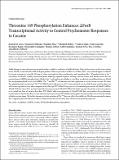Threonine 149 Phosphorylation Enhances ΔFosB Transcriptional Activity to Control Psychomotor Responses to Cocaine
Author(s)
Neve, Rachael L.; Cates, Hannah M.; Thibault, Mackenzie; Pfau, Madeline; Heller, Elizabeth; Eagle, Andrew; Gajewski, Paula; Bagot, Rosemary; Colangelo, Christopher; Abbott, Thomas; Rudenko, Gabby; Nestler, Eric J.; Robinson, Alfred J.; ... Show more Show less
DownloadCates-2014-Threonine 149 Phosph.pdf (2.554Mb)
PUBLISHER_POLICY
Publisher Policy
Article is made available in accordance with the publisher's policy and may be subject to US copyright law. Please refer to the publisher's site for terms of use.
Terms of use
Metadata
Show full item recordAbstract
Stable changes in neuronal gene expression have been studied as mediators of addicted states. Of particular interest is the transcription factor ΔFosB, a truncated and stable FosB gene product whose expression in nucleus accumbens (NAc), a key reward region, is induced by chronic exposure to virtually all drugs of abuse and regulates their psychomotor and rewarding effects. Phosphorylation at Ser[superscript 27] contributes to ΔFosB's stability and accumulation following repeated exposure to drugs, and our recent work demonstrates that the protein kinase CaMKIIα phosphorylates ΔFosB at Ser[superscript 27] and regulates its stability in vivo. Here, we identify two additional sites on ΔFosB that are phosphorylated in vitro by CaMKIIα, Thr[superscript 149] and Thr[superscript 180], and demonstrate their regulation in vivo by chronic cocaine. We show that phosphomimetic mutation of Thr[superscript 149] (T149D) dramatically increases AP-1 transcriptional activity while alanine mutation does not affect transcriptional activity when compared with wild-type (WT) ΔFosB. Using in vivo viral-mediated gene transfer of ΔFosB-T149D or ΔFosB-T149A in mouse NAc, we determined that overexpression of ΔFosB-T149D in NAc leads to greater locomotor activity in response to an initial low dose of cocaine than does WT ΔFosB, while overexpression of ΔFosB-T149A does not produce the psychomotor sensitization to chronic low-dose cocaine seen after overexpression of WT ΔFosB and abrogates the sensitization seen in control animals at higher cocaine doses. We further demonstrate that mutation of Thr[superscript 149] does not affect the stability of ΔFosB overexpressed in mouse NAc, suggesting that the behavioral effects of these mutations are driven by their altered transcriptional properties.
Date issued
2014-08Department
Massachusetts Institute of Technology. Department of Brain and Cognitive SciencesJournal
Journal of Neuroscience
Publisher
Society for Neuroscience
Citation
Cates, Hannah M., Mackenzie Thibault, Madeline Pfau, Elizabeth Heller, Andrew Eagle, Paula Gajewski, Rosemary Bagot, et al. “Threonine 149 Phosphorylation Enhances ΔFosB Transcriptional Activity to Control Psychomotor Responses to Cocaine.” Journal of Neuroscience 34, no. 34 (August 20, 2014): 11461–11469.
Version: Final published version
ISSN
0270-6474
1529-2401